Top 20 New Species Discovered In 2020 – Learn About Organisms Discovered In The Past Year
Life on Earth has existed for millions of years. However, there are still scores of living creatures that we are yet to discover. Scientists worldwide make progress in that area every year and last year was no different despite the COVID-19 pandemic. The fact that this well-trodden Earth could still present uncharted riches in its diverse ecosystems is mind-blowing.
The organisms discovered in the past year include plants, fungi, frogs, insects, snakes, marine organisms, and primates. Here are the top 20 species discovered in 2020.
- The Cliff-dwelling Bromeliad
Scientific name – Acanthostachys calcicola
Region – Central Brazil
Month & year of discovery/description – December 2019
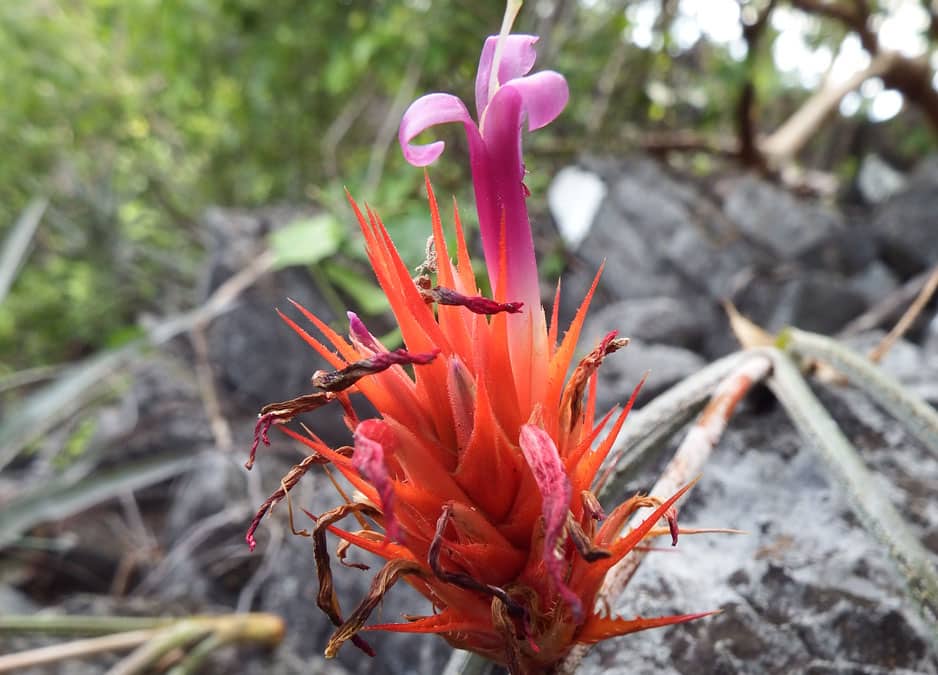
The Bromeliad family is one which pineapples belong to, and they’ve found a brand new member! The Acanthostachys calcicola was discovered in central Brazil’s limestone cliffs. These hummingbird-pollinated flowers were noticed by Brazilian botanists Gabriel Mendes Marcusso and Pablo Hendrigo Alves de Melo. Assisted by Alex Munro, a researcher at Kew Gardens, London, the scientists discovered only 25 specimens of this beautiful flower which seems to be in peril due to the limestone extraction taking place nearby for cement production purposes.
2. Orchid you not!
Scientific name – Orchidaceae
Region – New Guinea (Australia), Arunachal Pradesh (India), China, Sri Lanka, etc.
Month & year of discovery/description (in due order):
- Bulbophyllum dologlossum – November 2020
- Dendrobium aurifex – July 2020
- Spathoglottis arunachalensis – February 2020
- Gastrodia gunatillekeorum – May 2020
- Bulbophyllum trongsaense – September 2019
- Gastrodia agnicellus – December 2020
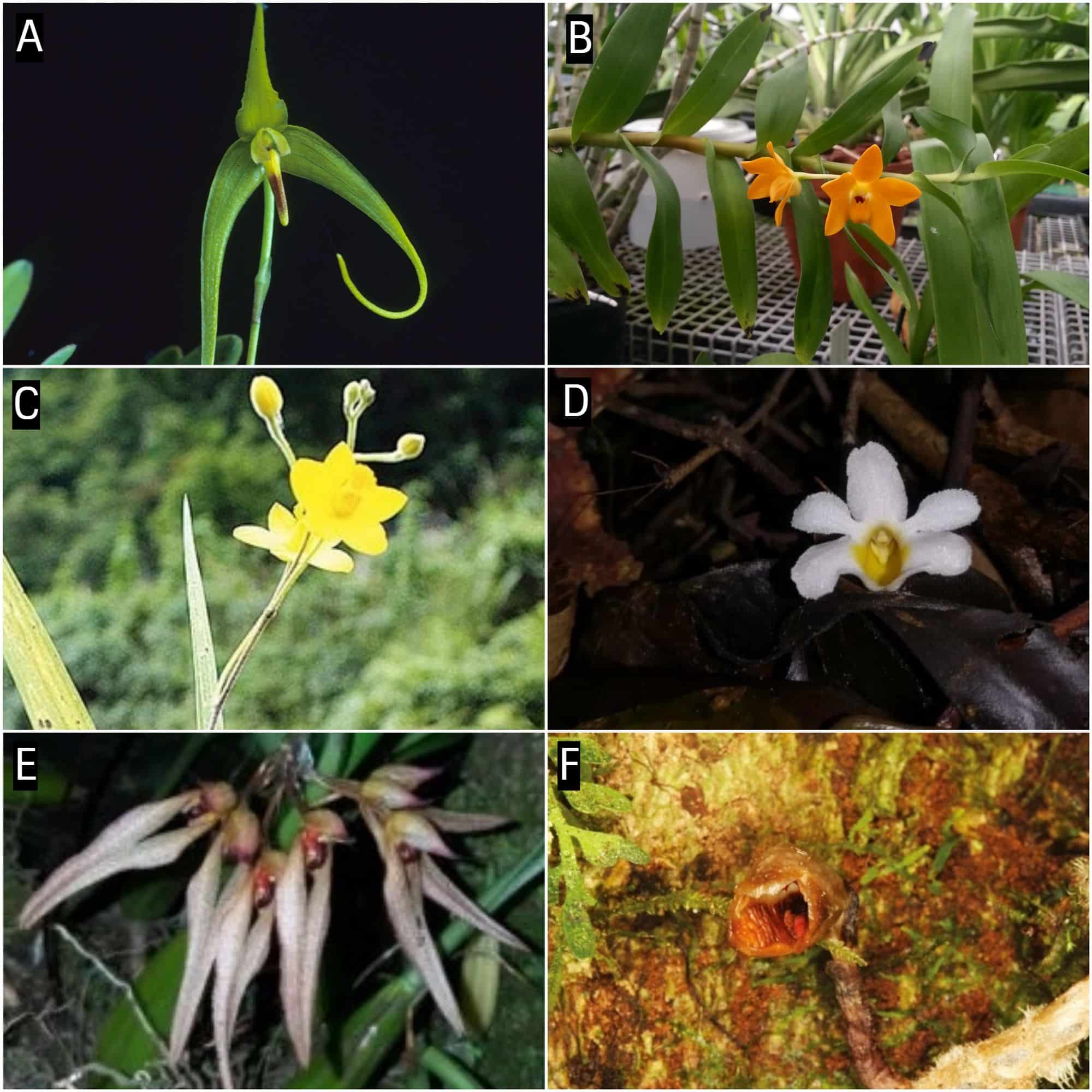
Orchids have always been exotic and alluring to people. With flowers that represent elegance and love, these plants are scientifically named Orchidaceae and belong to the family Asparagales, one of the 2 largest flowering plant families globally (the other one being Asteraceae). More than 28,000 orchid species are distributed throughout the planet, majorly growing in wet tropic regions as terrestrial forms, occurring below the ground, or as epiphytic forms (attached to woody plants).
New Guinea, where 19 new species have been found, has a rich botanical biodiversity. There are around 800 genera of orchids worldwide. Some of the Top 20 New Species discovered in 2020 are given below:
A. Bulbophyllum dologlossum was discovered in New Guinea, Australia. Bulbophyllum species appear hairy and are fly-pollinated.
B. Dendrobium aurifex was discovered in New Guinea. Dendrobium species are known for their beautiful flowers, which have horticultural and medicinal value.
C. Spathoglottis arunachalensis discovered in Arunachal Pradesh, India. Only 4 out of 50 species from this genus are found in India.
D. Gastrodia gunatillekeorum was discovered in Sri Lanka’s Sinharaja lowland rainforest. These endangered species belong to a mycotrophic genus in nature, i.e., they derive their nutrition from fungi.
E. Bulbophyllum trongsaense was discovered in Bhutan’s Lhuentse Dzongkhags and Trongsa regions. These are tree-dwelling species.
F. Known as the ‘Ugliest orchids in the world,’ Gastrodia agnicellus was discovered in Madagascar. They stand at the height of 11m and are perennial flowers.
3. ‘Scaling’-up, are we?
Scientific name – Tiganophyton karasense
Region – Southern desert of Namibia
Month & year of discovery/description – April 2020 (reported)
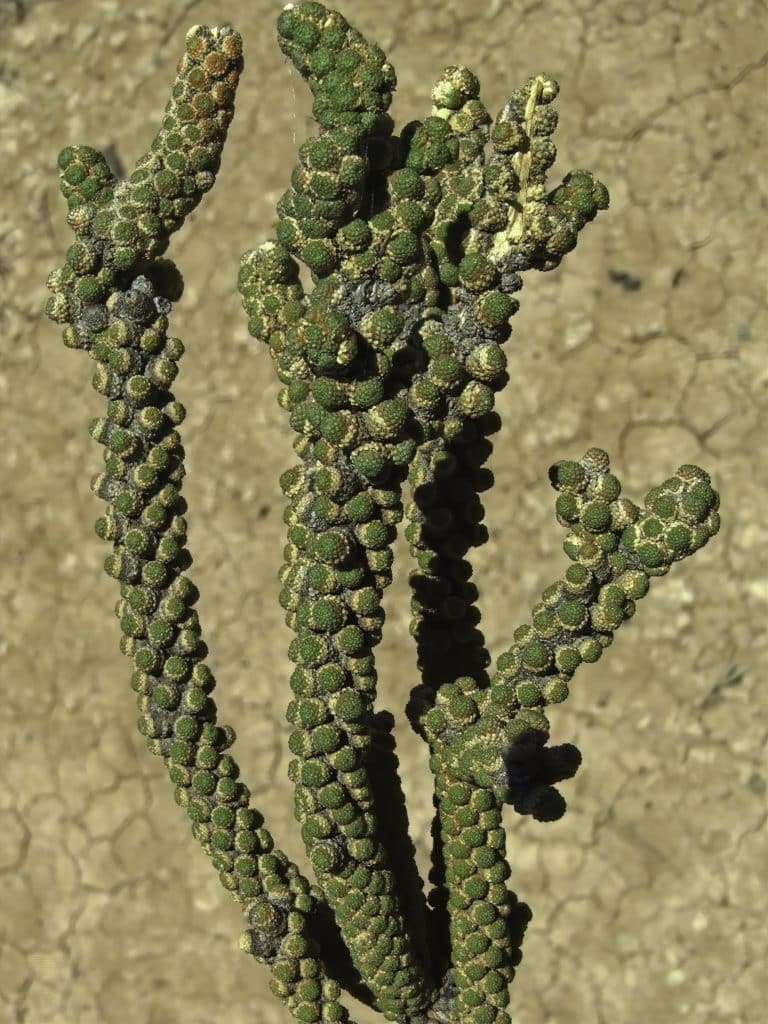
A rare evergreen desert plant was discovered in Namibia’s southern desert region. This dwarf shrub, Tiganophyton karasense, is so unique that DNA analysis of the species gave scientists enough evidence to place it in a whole new family called Tiganophyton along with cabbage and broccoli in the order Brassicales. With fewer than 1000 such plants known to exist, Tiganophyton karasense has scaly leaves and survival in semi-desert salt pans of 36 degrees Celsius as its distinctive features.
4. Has a beak, but not a bird
Scientific name – Undetermined (Beaked whales)
Region – Near San Benito islands off Mexico’s Pacific coast
Month & year of discovery/description – November 2020
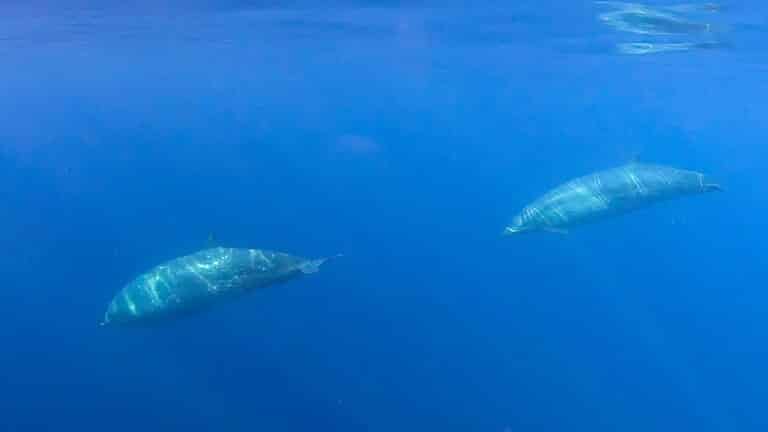
From the sultry sands of Namibia, we shift to the cool and refreshing Pacific ocean. Researchers who thought they had finally sighted a trio of the elusive and endangered Mesoplodon perrini (Perrin’s beaked whales) received a pleasant surprise. They had, in fact, encountered a whole new species of beaked whale, which differ from other beaked whale species both acoustically and physically and are part of our Top 20 New Species discovered in 2020. The scientists are yet to determine the exact taxonomy of this unique sea creature, for which their eDNA (environmental DNA) will be analyzed. Elizabeth Henderson and other researchers atop aboard the conversation group Sea Shepherd’s Martin Sheen vessel are thrilled to find such a large mammal that is 16.4 ft long, swims in the oceans was possibly unknown to humankind for so long.
5. Longest animal ever!
Scientific name – Siphonophorae (Coiled Siphonophore)
Region – Western Australia’s deep-sea canyons
Month & year of discovery/description – April 2020

Did you know that the world’s longest animal was considered to be the lion’s mane jellyfish? Well, forget that because here’s an animal that surpasses everything else to be the world’s longest animal ever at a whopping 150 ft length. Australian Schmidt Ocean Institute’s research vessel, Falkor, contained a team of scientists who have discovered up to 30 new species in the ocean! Among them is the coiled siphonophore, a complex organization comprising a colony of individual zooids that replicate themselves by thousands to extend into a stringlike body. Found about 2,000 feet under the sea, the organism was described as an underwater UFO.
6. The Underwater Party Balloon
Scientific name – Duobrachium sparksae
Region – Near Puerto Rico
Month & year of discovery/description – November 2020 (first discovered – April 2015)

The NOAA (National Oceanic and Atmospheric Administration) Fisheries Research Team discovered a new jellyfish species about 2.5 miles below the sea level which are part of our Top 20 New Species discovered in 2020. This new comb jelly or ctenophore species is indeed unique because evidence of its novelty was based purely on high-definition video evidence. Using the Deep Discoverer robot, the scientists were able to elucidate the organism’s morphological details, such as reproductive organs’ location, etc. Such an observation was necessitated due to the difficulty in processing the gelatinous animal, which isn’t suitable for preservation in the lab.
7. ‘Langur’-ound a bit longer
Scientific name – Trachypithecus popa
Region – Myanmar forests
Month & year of discovery/description – November 2020
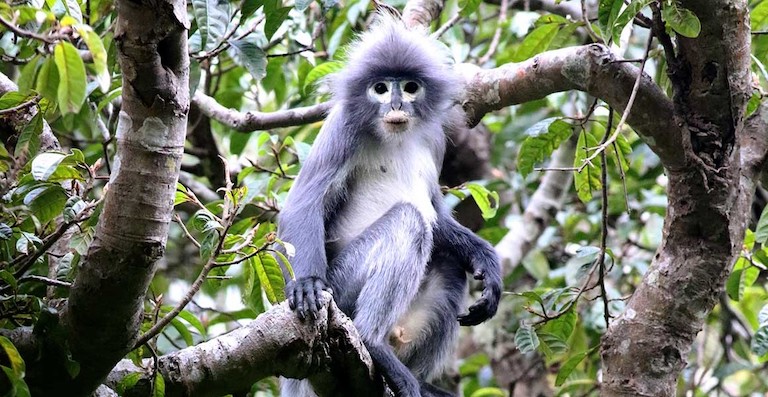
Not only mysterious sea creatures and exotic plants, but 2020 also saw scientists discovering a beautiful new Langur species, which is sadly also endangered. The Trachypithecus popa, also known as Popa Langur, was characterized in the lab with the wild animal’s fecal samples and tissue samples from captive species and museum specimens. Distributed across 4 populations, just 200-260 of these primates belonging to the Cercopithecidae family have been recorded. The IUCN Red List has categorized the species as “critically endangered,” among which the safest population lives in a 26 km square area of forests, making it hard for the species named after Mount Popa to sustain in such a small environment.
8. Lemur show you more
Scientific name – Microcebus jonahi
Region – Madagascar
Month & year of discovery/description – July 2020
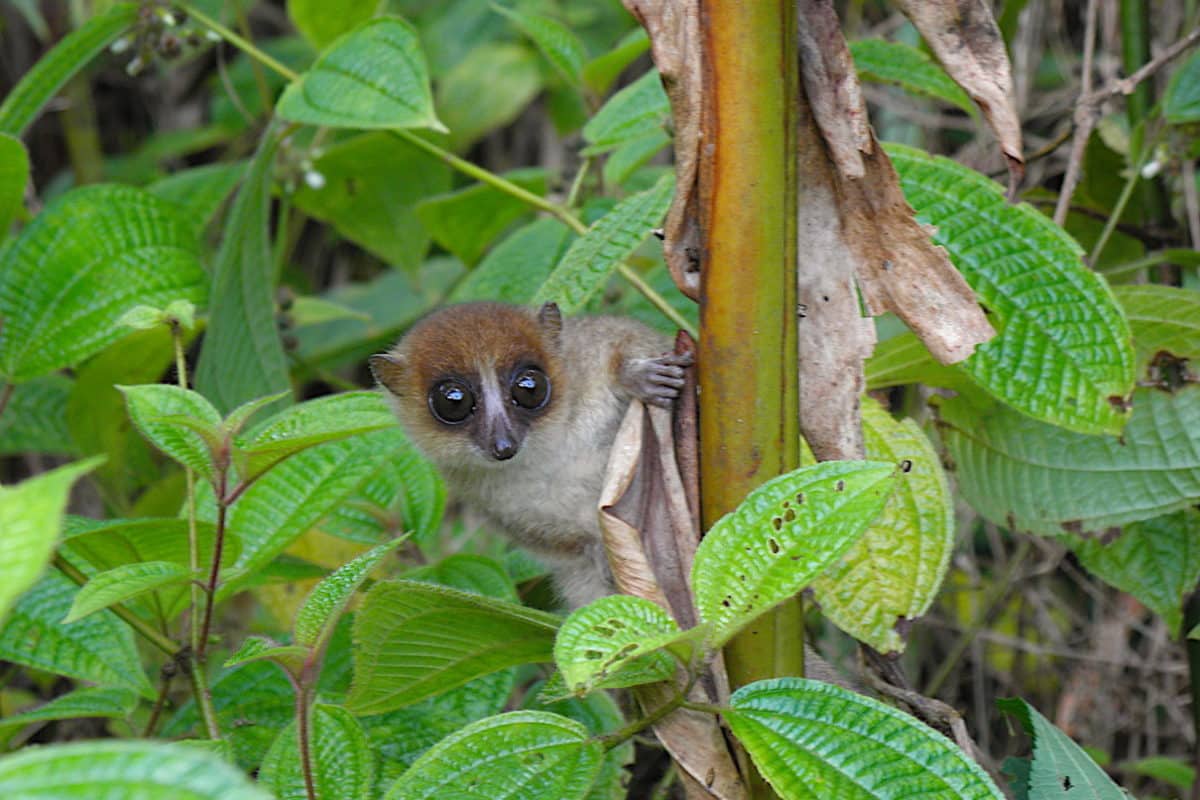
The smallest primates’ group on Earth, mouse lemurs, are mostly found in the Madagascar islands as shy, nocturnal animals and among our Top 20 New Species discovered in 2020. The Microcebus jonahi or Jonah’s mouse lemur is one of the 25 endangered mouse lemurs existing globally. They are slightly bigger in size when compared to an average mouse lemur. With a white stripe running across its dense fur, nose, and tiny ears, the reddish-brown mouse lemur populates the lowland rainforest that Madagascar’s Mananara Nord National Park lies in. Roughly resembling a human fist in size, these mouse lemurs were characterized as a whole new species based on the mitochondrial DNA and genomic data.
9. Hogwarts founder in the Himalayas
Scientific name – Trimeresurus salazar
Region – Arunachal Pradesh, India
Month & year of discovery/description – April 2020 (discovered in summer of 2019)
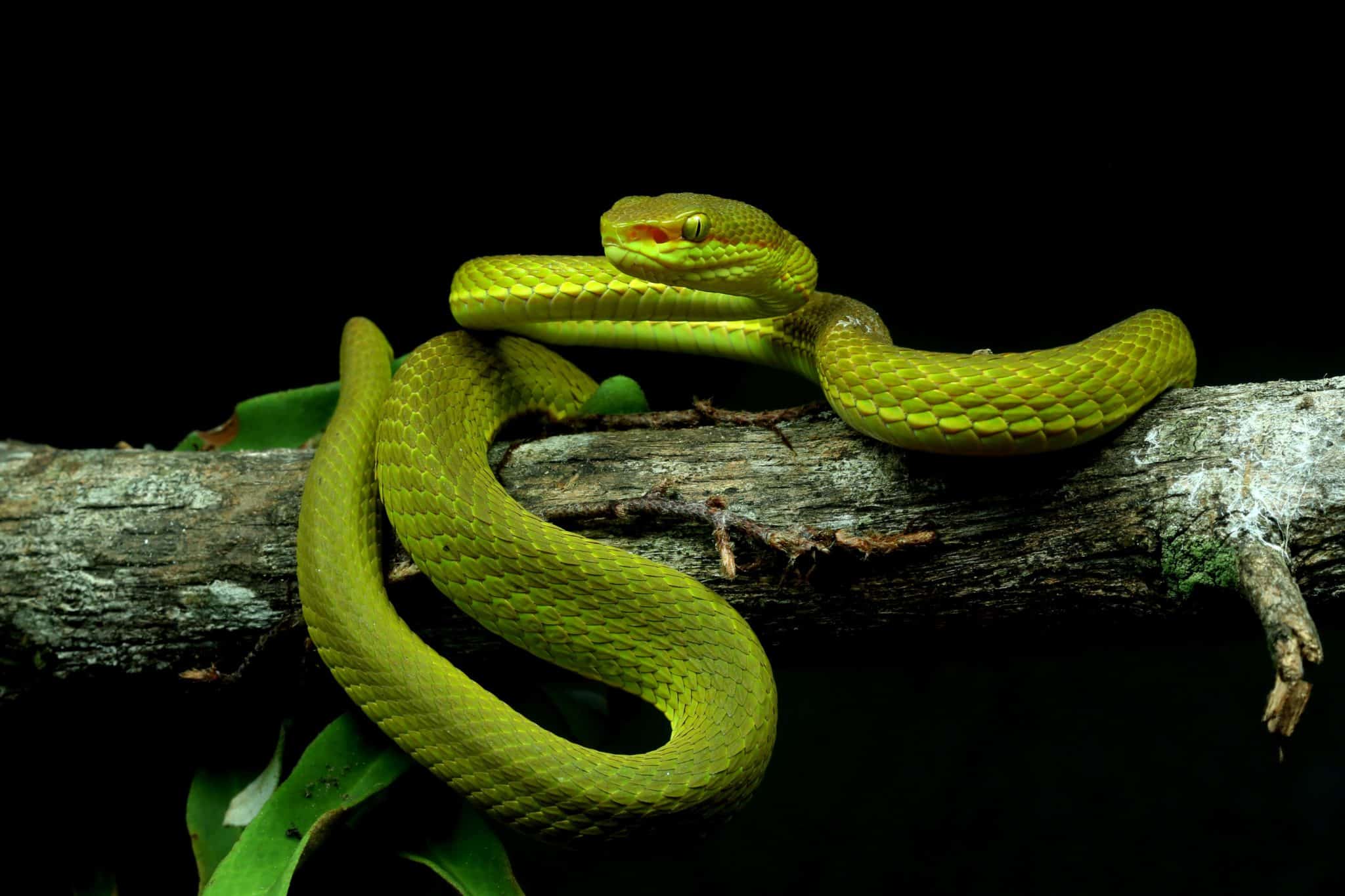
“Alohamora!” says this new species of Indian pit viper, opening doors to a unique new name for itself. The bright green colored nocturnal snake was discovered in India’s northeastern-most state, Arunachal Pradesh. With DNA evidence leading to scientists mapping a resemblance to the Himalayan white-lipped viper, this male of this species bears a rusty red stripe across the face and body. This charismatic, venomous Trimeresurus genus has 48 discovered species distributed across Asia’s southeastern and eastern regions. And what’s better than a dynamic group of scientists bitten by the pop-culture bug? They actually named this beautiful species reminiscing the one it resembles – the ‘talking’ snake in Harry Potter! Salazar Slytherin, after whom the reptile is named, is one of the 4 Hogwarts founders. Well, what else can you say but… 50 points for Slytherin!
10. This snake really shines bright
Scientific name – Achalinus zugorum
Region – Ha Giang province, Vietnam
Month & year of discovery/description – December 2020
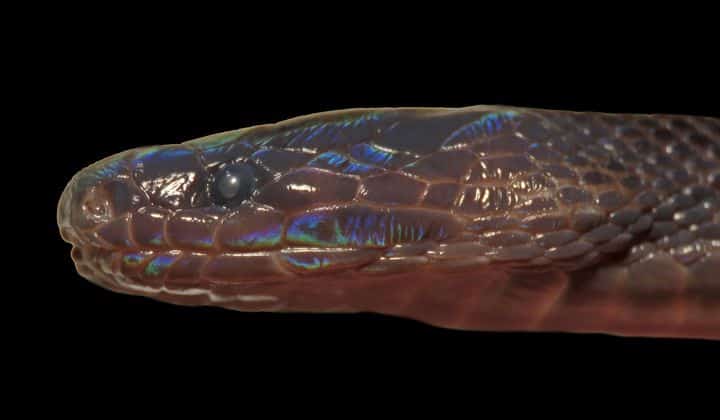
All that glitters isn’t gold – it can even be a snake! Researchers have discovered a new rare iridescent snake species in the dense jungles of Vietnam which is part of our Top 20 New Species discovered in 2020. The reptile seems to have adapted itself to the underground, burrowing way of life by displaying in its eyes a lack of bright-light photoreceptors, in addition to its unique iridescence and unusually-patterned scales. They have evaded human eyes for a long due to their underground habitat, but this very feature, along with its rare genus, is expected to shine a light on snakes’ evolution. The Achalinus zugorum named after George Zug, Smithsonian Museum’s retired curator of reptiles and amphibians, may have evolved earlier than most other snakes. The snake’s DNA was sampled and sequenced in the Smithsonian, where it joined the biorepository and was identified as a new species.
11. Indeed a ‘leap’ year for this one
Scientific name – Noblella sp. nov.
Region – Zongo Valley, Bolivia
Month & year of discovery/description – August 2020 (first discovered in 2012)
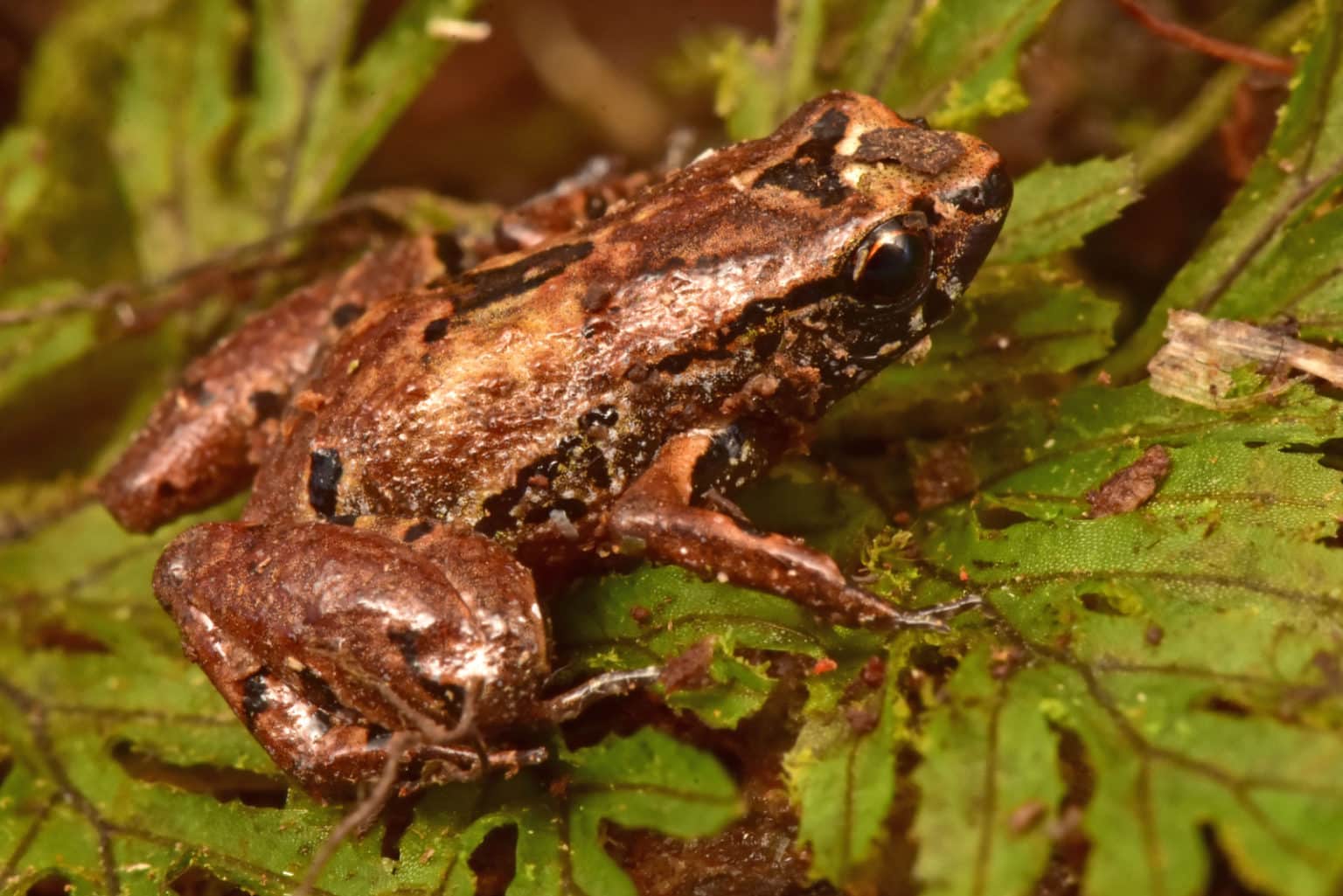
Imagine a frog the size of an aspirin tablet. Well, that’s how small this lilliputian frog measuring around 10 mm, is. Found near Bolivia’s La Paz in tunnels underneath the humus and moss of Zongo Valley’s cloud forests, this tiny frog has a distinctive call and was extremely difficult to find. The researchers discovered it also has 20 other new species in the Zongo Valley, including several new butterflies, orchids, few species previously deemed extinct, Oreobates zongoensis (the devil-eyed frog), and Bothrops monsignifer (a new mountain fer-de-lance).
12. ‘What’s in a name?’
Scientific name – Eurycea arenicola
Region – North Carolina, USA
Month & year of discovery/description – December 2020 (first discovered in 1960)
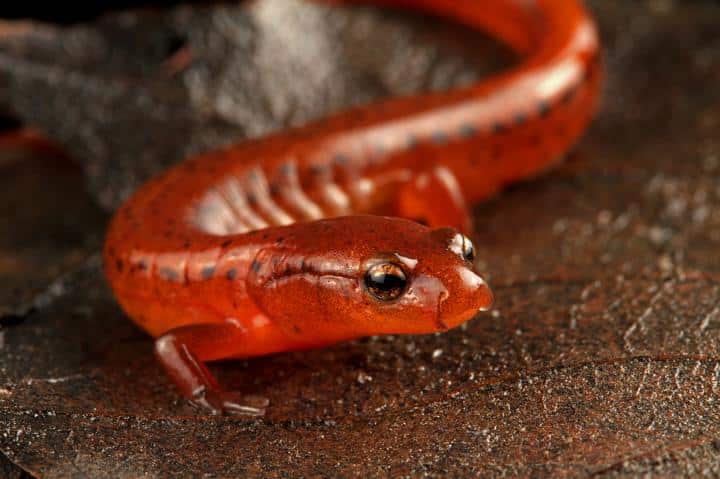
50 years after its actual discovery, this shiny new salamander species has finally been named. The amphibian which is a part of our Top 20 New Species discovered in 2020, which was found in North Carolina’s Sandhills region’s small streams and springs, was identified using next-generation sequencing technology to be genetically different from other two-lined salamander species in terms of both its nuclear and mitochondrial DNA. As part of the North Carolina Natural Heritage Program’s W3 Watch List, this organism is poorly known despite its early discovery.
13. Even Bacteria fight climate change!
Scientific name – Paraburkholderia madseniana sp. nov.
Region – Near Ithaca, NY State, USA
Month & year of discovery/description – February 2020

This is undoubtedly a trying time for the planet, with people gaining increasing awareness about climate change. Well, who thought a bacterial species would already be acting on it? Paraburkholderia madseniana is a Gram-negative bacterium discovered in the acidic forest solid near Ithaca and degrades phenolic acids. They are particularly proficient in breaking down the organic matter, including carcinogenic chemicals released during the burning of oil, coal, gas, and refuse. Some species of this genus also have the ability to fix atmospheric nitrogen by forming root nodules. These bacteria’s major advantage is their ability to degrade pollutants in contaminated soils, especially PAHs (Polycyclic Aromatic Hydrocarbons), which are hazardous in nature. This novel species could be used extensively in biodegradation research.
14. We can’t resist antibiotics, but they do
Scientific name – Scandinavium goeteborgense
Region – Gothenberg, Sweden
Month & year of discovery/description –November 2019
The researchers of Gothenberg have isolated a new antibiotic-resistant bacterial species from infected wounds. Belonging to the Enterobacteriaceae family and part of our Top 20 New Species discovered in 2020, these bacteria were identified by next-generation DNA sequencing techniques, which revolutionized bacterial diagnosis and surveillance. They belong to a genus that comprises Gram-negative, rod-shaped bacteria, motile, oxidase-negative, and facultatively anaerobic. Although discovered in 2014 in the patient samples taken at Gothenberg’s Sahlgrenska University Hospital, this species’ name was validly published in IJSEM (International Journal of Systematic and Evolutionary Microbiology) in March 2020.
15. More room for Mushrooms, please!
Scientific name – Cortinarius heatherae
Region – Heathrow Airport, London
Month & year of discovery/description – March 2020
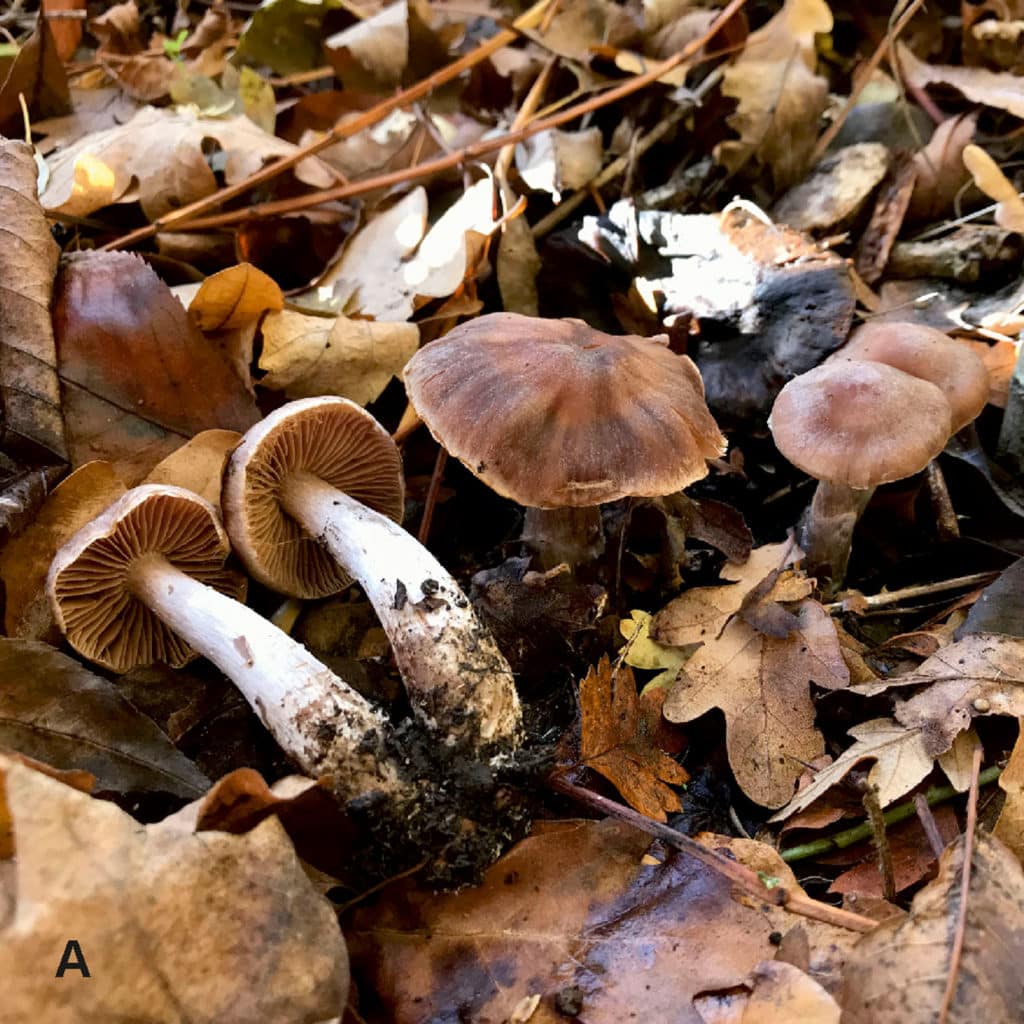
One can’t move on from microorganisms without noting a beloved fungus – mushroom. 2020 saw 6 new webcap toadstool mushroom species that were discovered in England and Scotland. Every one of the six mushrooms belongs to the Cortinarius genus, which is known for being widely known for sustaining pine and oak trees’ growth. One of these, Cortinarius heatherae, was found in one of the world’s busiest airports, London’s Heathrow airport, by a river running along the area’s boundary.
16. 15 more of the Wasp(s)
Scientific name – Acrotaphus sp.
Region – Andean cloud forests, Amazon rainforest of Brazil
Month & year of discovery/description – January 2020
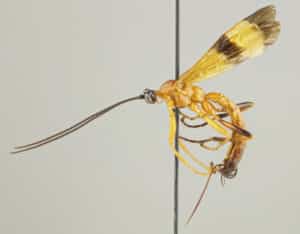
Entomologists everywhere are in for a treat as 15 new wasp species belonging to the Acrotaphus genus have been discovered by a team of researchers in the Amazon rainforest and Andean cloud forests. The specialty of this genus which is part of our Top 20 New Species discovered in 2020, lies in the way they parasitize spiders. A spider is first temporarily paralyzed in its web by the female Acrotaphus wasp, which lays on the spider, a single egg. The developing wasp pupa is unknowingly protected by this gullible spider host’s protective web, which the newly-hatched wasp then consumes. The newborn moves on pupating in its specially built web.
17. Meet the Ecosystem Engineers
Scientific name – Leptarma biju
Region – Kerala, India
Month & year of discovery/description – September 2020
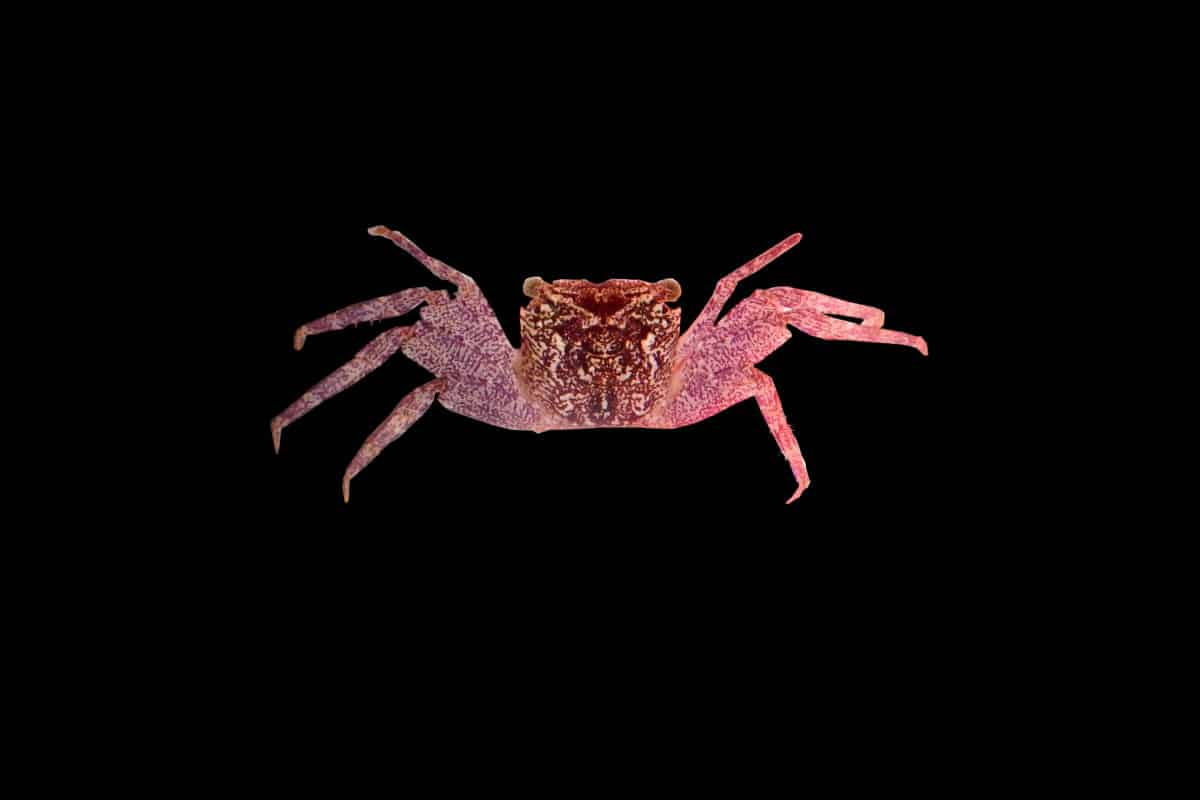
We did mention spiders; why not talk about the marvelous spider-crab that lives in the mangroves of Kerala? This magnificent purple-colored tree spider-crab is extremely small, encompassing all 13-14 mm, and was found at the Chithari river’s mouth. Since they aerate the soil while burrowing and recycling nutrients as part of their diet, Leptarma biju is called the ‘Ecosystem Engineers’ of the mangroves. This region of India has a rich biodiversity that is largely hidden and remains further discovered by researchers.
18. Batman’s nemesis, the… spider!
Scientific name – Loureedia phoenixi
Region – Iran
Month & year of discovery/description – June 2020
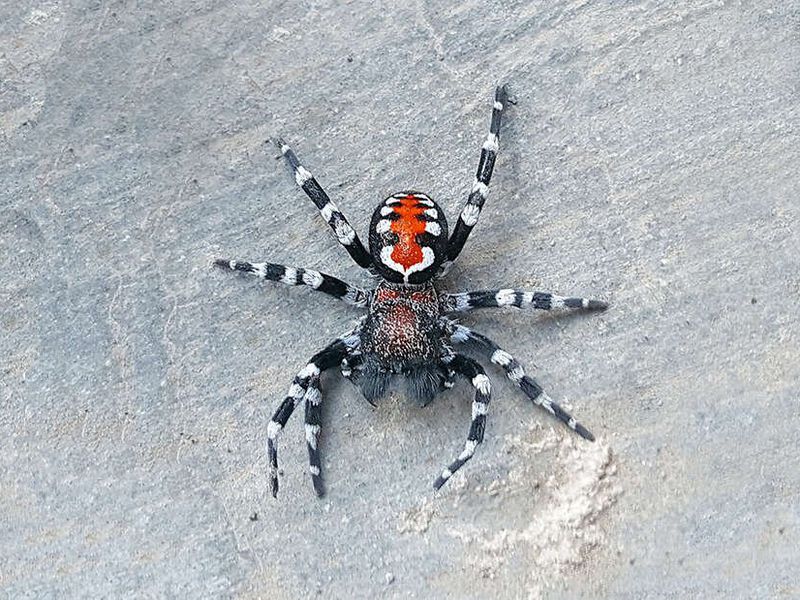
Scientists have interestingly named this new beautiful spider species which is a part of our Top 20 New Species discovered in 2020, after the actor who plays Batman’s nemesis, the Joker, Joaquin Phoenix, on its unique appearance. Its remarkable red and white pattern certainly reminds one of the character’s grin. This new velvet spider species was discovered just outside the Mediterranean and are the first of its species. It is a tiny creature, measuring only 0.3 inches or 8 mm in length, is the first of its genus to be discovered. Its unique features also include caring for their young cooperatively and building communal nests.
19. Birds of a different feather
Scientific name – Phylloscopus emilsalimi
Region – Taliabu island, Indonesia
Month & year of discovery/description – January 2020
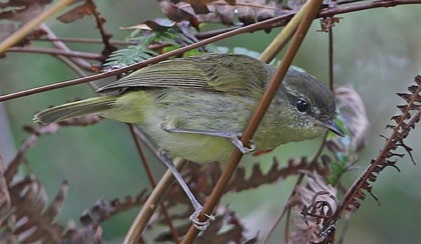
This list wouldn’t be complete without something for the ornithologists now, would it? Commonly known as the Taliabu leaf warbler, these new bird species were found in Indonesia’s Taliabu and neighboring Mangole islands. First described in 2020, it is a species of Old World Warbler belonging to the Phylloscopidae family. Not much is currently known about this species among the 10 newly discovered bird taxa in Indonesia.
20. The adorable Greater Gliders
Scientific name – Petauroides volans, Petauroides minor and Petauroides armillatus
Region – Eastern Australia forests
Month & year of discovery/description – November 2020
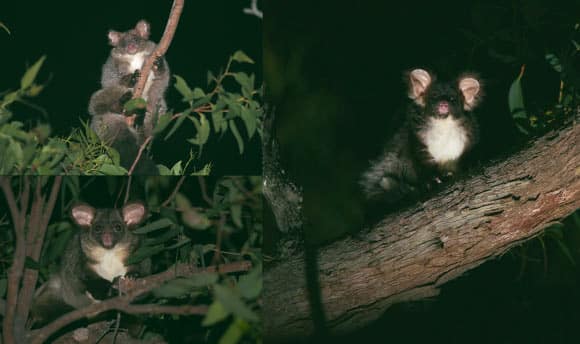
Let’s end this list of Top 20 New Species Discovered in 2020 with a bonus of 3 new species! The Greater Gliders are basically possum-like mammals residing in the forests of Eastern Australia. They generally sustain with the help of eucalyptus leaves on the top of the forests’ trees. Previously known as one single species, new DNA-supported evidence uncovered the existence of 3 morphologically different species – the Petauroides armillatus, Petauroides minor, and Petauroides volans. They appear as creatures adorned by white and light grey colors. These are nocturnal gliding marsupials labeled as vulnerable in Australia.
This was a description of the top 20 species discovered in 2020. The world is teeming with many more diverse organisms waiting to be discovered by curious scientists and explorers.



